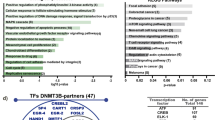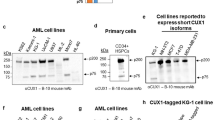Abstract
The BTB/POZ transcriptional repressor HIC1 (Hypermethylated in Cancer 1) is a tumor suppressor gene located at chromosome 17p13.3, a region frequently hypermethylated or deleted in human tumors and in a contiguous-gene syndrome, the Miller–Dieker syndrome. The human and murine HIC1 genes are composed of two alternative 5′ exons, 1a and 1b fused to a large second coding exon 2. Exon 1a is a noncoding exon associated with a major G–C-rich promoter whereas exon 1b is a downstream coding exon associated with a minor TATA box promoter. By human–mouse genome comparison, we have identified a short upstream conserved sequence containing G–C boxes which were shown to be functional. Transcripts initiating from this new promoter were detected in various human and mouse tissues and contained a long 5′-UTR sequence, called 1c which encompass the G–C-rich promoter associated with exon 1a and uses the same splice donor site. RT–PCR analyses of two primary breast epithelial cell lines identified two other 5′-UTRs generated by alternative splicing within exon 1c. Our results thus highlight the existence of an unexpected complex transcriptional regulation of HIC1.
This is a preview of subscription content, access via your institution
Access options
Subscribe to this journal
Receive 50 print issues and online access
$259.00 per year
only $5.18 per issue
Buy this article
- Purchase on Springer Link
- Instant access to full article PDF
Prices may be subject to local taxes which are calculated during checkout





Similar content being viewed by others
References
Baylin SB, Esteller M Rountree MR, Bachman KE, Schuebel K and Hermann JG . (2001). Hum. Mol. Genet., 10, 687–692.
Baylin SB, Herman JG, Graff JR, Vertino PM and Issa JP . (1998). Adv. Cancer Res., 72, 141–196.
Bruening W, Prowse AH, Schultz DC, Holgado-Madruga M, Wong A and Godwin AK . (1999). Cancer Res., 59, 4973–4983.
Carter MG, Johns MA, Zeng X, Zhou L, Zink MC, Mankowski JL, Donovan DM and Baylin SB . (2000). Hum. Mol. Genet., 9, 413–419.
Chen WY, Zeng X, Carter M, Morell CN, Chiu Yen R-W, Esteller M, Watkins DN, Herman JG, Mankowski JL and Baylin SB . (2003). Nat. Genet., 33, 197–202.
Deltour S, Guérardel C and Leprince D . (1999). Proc. Natl. Acad. Sci. USA, 96, 14831–14836.
Feltus FA, Lee EK, Costello JF, Plass C and Vertino PM . (2003). Proc. Natl. Acad. Sci. USA, 100, 12253–12258.
Fujii H, Biel MA, Zhou W, Weitzman SA, Baylin SB and Gabrielson E . (1998). Oncogene, 16, 2159–2164.
Guérardel C, Deltour S, Pinte S, Monte D, Bègue A, Godwin AK and Leprince D . (2001). J. Biol. Chem., 276, 3078–3089.
Grimm C, Spörle R, Schmid TE, Adler I-D, Adamski A, Schughart K and Graw J . (1999). Hum. Mol. Genet., 8, 697–710.
Han B, Dong Z, Liu Y, Chen Q, Hashimoto K and Zhang J-T . (2003). Oncogene, 22, 5325–5337.
Kanai Y, Hui A, Sun L, Ushijima S, Sakamoto M, Tsuda M and Hirohashi S . (1999). Hepatology, 29, 703–709.
Ko LJ and Prives C . (1996). Genes Dev., 10, 1054–1072.
Kozak M . (1991). J. Cell Biol., 115, 887–903.
Liscia DS, Morizio R, Venesio T, Palenzona C, Donadio M and Callahan R . (1999). Br. J. Cancer, 80, 821–826.
Makos-Wales M, Biel M, El Deiry W, Nelkin BD, Issa JP, Cavenee WK, Kuerbitz SJ and Baylin SB . (1995). Nat. Med., 1, 570–577.
Melki JR, Vincent PC and Clark SJ . (1999). Leukemia, 13, 877–883.
Philips NJ, Ziegler MR and Deaven LL . (1996). Cancer Lett., 102, 85–90.
Rood BR, Zhang H, Weitman DM and Cogen PH . (2002). Cancer Res., 62, 3794–3797.
Schultz D, Vanderveer L, Berman DB, Hamilton TC, Wong AJ and Godwin AK . (1996). Cancer Res., 56, 1997–2002.
Yingling J, Toyo-oka K and Wynshaw-Boris A . (2003). Am. J. Hum. Genet., 73, 475–488.
Yuasa Y . (2002). Mech. Ageing Dev., 123, 1649–1654.
Acknowledgements
This work was supported by funds from CNRS, the PASTEUR Institute, Ligue Régionale contre le Cancer (Comité de l'Aisne) and a grant from the NIH (Ovarian Cancer SPORE P50 CA83638). We thank Patrick Dumont for dissection of mouse tissues and Agnès Bègue for the murine ovaries cDNA fractions. We also thank Agnès Bègue, Jean Coll and Brian Rood for their comments on the manuscript.
Author information
Authors and Affiliations
Corresponding author
Additional information
The nucleotide sequences reported in this paper have been deposited to the EMBL database under Accession Numbers: AJ414163, AJ550616, AJ585343, AJ583693, AJ583594 and AJ585343
Rights and permissions
About this article
Cite this article
Pinte, S., Guérardel, C., Deltour-Balerdi, S. et al. Identification of a second G–C-rich promoter conserved in the human, murine and rat tumor suppressor genes HIC1. Oncogene 23, 4023–4031 (2004). https://doi.org/10.1038/sj.onc.1207504
Received:
Revised:
Accepted:
Published:
Issue Date:
DOI: https://doi.org/10.1038/sj.onc.1207504
Keywords
This article is cited by
-
The tumor suppressor Hic1 maintains chromosomal stability independent of Tp53
Oncogene (2018)
-
Signification of Hypermethylated in Cancer 1 (HIC1) as Tumor Suppressor Gene in Tumor Progression
Cancer Microenvironment (2012)
-
Requirement for chromatin-remodeling complex in novel tumor suppressor HIC1-mediated transcriptional repression and growth control
Oncogene (2009)
-
Identification of the p53 family-responsive element in the promoter region of the tumor suppressor gene hypermethylated in cancer 1
Oncogene (2006)



